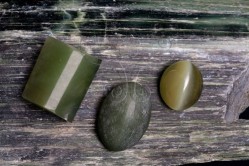|

Description
Taiwanese nephrite, also known as "Soft Jade", is mainly found at Fongtian in Hualien so it is also known as "Fongtian Jade". Hardness is between 6 and 6.5 with specific gravity ranging from 2.98 to 3.10. Nephrite can be white, gray, black, green and yellow-green in color with white striations, and is often found with companion minerals such as garnet, talc and pyrite. The three types of nephrite in Taiwan are common nephrite, Cat's Eye nephrite and waxy nephrite. Common nephrite is the most common type of nephrite found and is of average translucence with a glassy luster; waxy nephrite appears as gray-blue in color and is more opaque with a waxy luster. There is also a special species where the long thin fibers inside the mineral are arranged in parallel and follow a set direction. When polished to give it a convex surface, a "cat's eye" effect appears under light so it is called "Cat's Eye Nephrite".
Mineral Formation
Taiwanese nephrite is composed mainly of tremolite and actinolite. It is found in Hualien's Fongtian region within the contact zone between the serpentine and graphite-based sericite quartz schist. It is formed by hydrothermal alternation and is often found with garnet, talc and pyrite as its companion minerals.
Geographic Distribution
In Hualien County at Fongtian in Shoufong Township and Silin in Sioulin Township.
Mining History
The inhabitants of Taiwan mastered the making of Nephrite tools five thousand years ago. The craft was particularly well-developed by the Neolithic period with the Binan culture using Taiwanese nephrite to make jewelry and everyday items.
In 1932 a Japanese surveyor named Nakajima found white, fibrous asbestos at Laonaoshan in Hualien. Large-scale mining followed as asbestos was an important strategic material for Japan during World War II. Its companion mineral nephrite was considered worthless. It was not until the 1960's that it was confirmed to be nephrite by Professor Liao Syue-cheng at Cheng Kung University, triggering a mining frenzy in Taiwan.
Mining of Taiwanese nephrite commenced in 1965 and production increased every year. Statistics indicate that Taiwanese nephrite accounted for 60% of global nephrite production between 1962 and 1986. Production peaked in 1975 with 1,461 tonnes mined in a year and accounted for 90% of global output. A global financial crisis as well as rising mining costs and over-exploitation led to a gradual decline in nephrite production. No more mines were opened after 1980.
Production
Between 1962 and 1986 up to 11,093 tonnes of Taiwanese nephrite were mined and accounted for 60% of the global nephrite production. Production peaked in 1975 with 1,461 tonnes mined in a year accounting for 90% of the global output. By 1980, Nephrite production had dropped to just 480 tonnes.
Applications
Jewelry, crafts and decorations.
National Museum of Natural Science
|